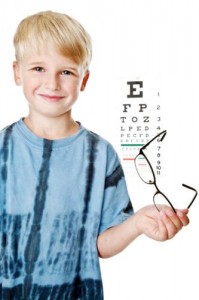Did your child pass the vision screening administered at school last year? Did he see the acuity chart tacked to the door at the pediatrician’s office? Although these tests are helpful in spotting a few basic eye problems, they don’t take the place of a comprehensive eye examination.
Very often screening tests simply measure how well your child can see at a distance. Other vision concerns, such as farsightedness, lazy eye, crossed eyes, poor eye coordination, or poor depth perception may go undetected. Often children do not recognize these problems themselves because they have “always seen it this way.”
Parents and teachers may be puzzled about a child’s slow progress in school. For example, if a child is farsighted, he or she will see distant objects clearly, but may have problems focusing the eyes for close work. The same child who can read the eye chart easily at a distance may have a difficult time seeing words close up in a textbook or on a math worksheet. As a result, reading problems may develop that can affect the student’s learning and achievement.
A comprehensive eye examination includes measurements of the vision at distances far away which is important for seeing the board and playing sports and closer distances which are important for reading, computers and desk work. The exam also includes evaluation of how the eyes work together and the ocular health.
Success during the first few years of school can significantly impact your child’s confidence and success. If a child can’t focus, track (follow words on a page) and otherwise see properly, reading and development will be delayed making school a frustrating experience.
When scheduling back-to school appointments, don’t forget to include the eye doctor.
